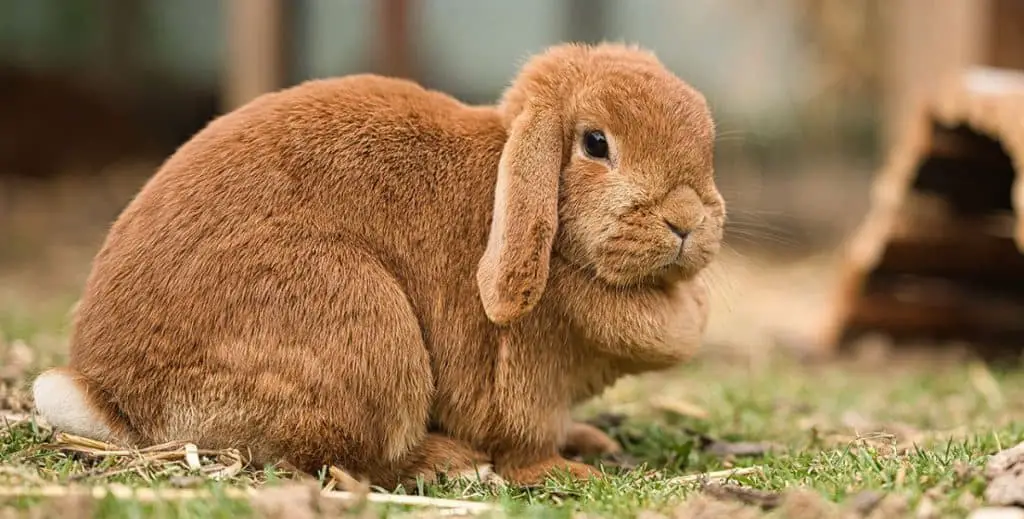Disclosure: We may earn money or products from the companies mentioned in this post.

A dewlap is a flap of skin and fat that hangs from the neck under the lower jaw of many mammals, including rabbits. Most people see a dewlap as the equivalent of a double chin on a human.
In this article, we’ll focus on rabbit dewlaps and specifically consider dewlaps on Holland Lops.
Are Holland Lops More Likely To Get A Dewlap Than Other Rabbit Breeds?

Dewlaps are more common on larger breeds of bunnies than on smaller breeds.
Likewise, dewlaps are more common on loser skin rabbits which includes lop-eared bunnies.
Giving that Holland Lops are a smaller breed and lop-eared, they are more likely than some breeds to develop large dewlaps and less likely than others. Large lose skinned rabbits such French Lops are much more likely than Holland Lops to developed significant dewlaps
Do Both Male And Female Rabbits Get Dewlaps?
Female rabbits naturally store more fat as they mature so they are better prepared to raise bunnies and a dewlap is a combination of loose skin and fat.
Both male and female rabbits can develop dewlaps as they age, but female rabbits are much more likely to develop larger more fat filled dewlaps than male rabbits.
Do All Female Rabbits Get Dewlaps?
Female rabbits are more likely to develop large dewlaps because they naturally store fat for potential litters of bunnies.
It also seems that mother rabbits use the dewlap as the primary source of fur to line their nests when giving birth to a litter of bunnies.
However, once you spay a female rabbit that propensity to store fat is greatly reduced and so is the likelihood of getting a large dewlap.
Also, keep in mind that large loose skinned breeds of rabbits are more likely to develop dewlaps, so not all unspayed female rabbits are equally predisposed to large dewlaps.
All female rabbits do not get dewlaps. Spayed females are way less likely to get larger dewlaps than unspayed females who are prone to naturally storing fat for potential babies. Also, females from larger lose-skinned rabbit breeds are more likely to develop large dewlaps.
Does A Dewlap Mean My Rabbit Is Fat?
A dewlap is a loose piece of skin under the neck. That flap of skin contains fat and when it grows to larger sizes it’s because it is filling with more fat.
A bunny’s dewlap will get larger as they gain fat weight. A very larger dewlap is usually an indicator of an obese rabbit. As a rabbit loses weight and returns to a leaner and healthier state, the dewlap will shrink in size
You should keep in mind that a small dewlap is a natural characteristic of large lose-skinned rabbits. Also, remember that a slightly larger dewlap is natural and healthy on an unspayed female who is storing fat for potential litters of babies.
A small pillow dewlap under a mature rabbit’s chin is not a cause for concern.
However, if you see that your pet bunny’s healthy dewlap is growing in size, you should take a careful look at their diet to make sure that they are not gaining unhealthy weight.
Do Dewlaps Cause Problems For Bunnies?
A small dewlap will not cause any problems for your bunny, but as it grows there are potential problems that could arise for your rabbit.
The primary concern with a large dewlap is that your rabbit might be becoming obese which is not a healthy state for a rabbit.
Obesity can cause your rabbit stress, heart decease, and even diabetes.
If your rabbit has become obese, you need to carefully consider their diet and start moving them towards a healthier way of eating that includes hay, high-quality pellets, and very few treats, even including vegetables.
A large dewlap can cause other health problems for your bunny not directly related to obesity.
A very large dewlap can act as a pillow that keeps your bunny from moving its head naturally. This can make it difficult, or even impossible, for the rabbit to groom herself or even eat & drink.
It’s also possible that a very large dewlap can develop sores similar to bed sores on humans. This is caused by moisture, bacterial, and dirt becoming trapped in the folds of an inflated dewlap.
You can help alleviate these potential problems by helping your bunny groom, but the real solution is probably weight loss.
If your bunny is demonstrating health issues related to a large dewlap, you should consult with your veterinarian. In extreme cases, some vets will even surgically reduce the size of a dewlap, though I’d encourage you to fully explore natural weight loss before undertaking the stress and expense of surgery.
